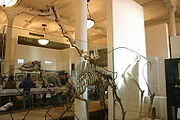
Procamelus
Encyclopedia
Procamelus is an extinct genus of terrestrial
herbivore
the family
Camelidae, endemic to North America
from the Oligocene
through Miocene
20.6—4.9 mya, existing for approximately .
 Priscocamelus was named by Leidy (1858). It is not extant. It was assigned to Camelidae by Leidy (1858) and Carroll (1988).
Priscocamelus was named by Leidy (1858). It is not extant. It was assigned to Camelidae by Leidy (1858) and Carroll (1988).
The name is derived from the Greek πρό, meaning "before", and κάμελος (camel), thus "early camel."
. Unlike modern camelids, it had a pair of small incisor
teeth in the upper jaw. The remaining teeth were large and adapted for eating tough vegetation. The shape of the toes suggests that it possessed foot pads, like modern camels, but unlike earlier forms of camelid, which generally had hooves. This would have helped it walk over relatively soft ground.
It had a straighter neck than Oxydactylus
orAepycamelus
.
Terrestrial animal
Terrestrial animals are animals that live predominantly or entirely on land , as compared with aquatic animals, which live predominantly or entirely in the water , or amphibians, which rely on a combination of aquatic and terrestrial habitats...
herbivore
Herbivore
Herbivores are organisms that are anatomically and physiologically adapted to eat plant-based foods. Herbivory is a form of consumption in which an organism principally eats autotrophs such as plants, algae and photosynthesizing bacteria. More generally, organisms that feed on autotrophs in...
the family
Family (biology)
In biological classification, family is* a taxonomic rank. Other well-known ranks are life, domain, kingdom, phylum, class, order, genus, and species, with family fitting between order and genus. As for the other well-known ranks, there is the option of an immediately lower rank, indicated by the...
Camelidae, endemic to North America
North America
North America is a continent wholly within the Northern Hemisphere and almost wholly within the Western Hemisphere. It is also considered a northern subcontinent of the Americas...
from the Oligocene
Oligocene
The Oligocene is a geologic epoch of the Paleogene Period and extends from about 34 million to 23 million years before the present . As with other older geologic periods, the rock beds that define the period are well identified but the exact dates of the start and end of the period are slightly...
through Miocene
Miocene
The Miocene is a geological epoch of the Neogene Period and extends from about . The Miocene was named by Sir Charles Lyell. Its name comes from the Greek words and and means "less recent" because it has 18% fewer modern sea invertebrates than the Pliocene. The Miocene follows the Oligocene...
20.6—4.9 mya, existing for approximately .
Taxonomy

The name is derived from the Greek πρό, meaning "before", and κάμελος (camel), thus "early camel."
Morphology
It had long legs designed for speed, and was about 1.3 metres (4.3 ft) in height, slightly smaller than a modern llamaLlama
The llama is a South American camelid, widely used as a meat and pack animal by Andean cultures since pre-Hispanic times....
. Unlike modern camelids, it had a pair of small incisor
Incisor
Incisors are the first kind of tooth in heterodont mammals. They are located in the premaxilla above and mandible below.-Function:...
teeth in the upper jaw. The remaining teeth were large and adapted for eating tough vegetation. The shape of the toes suggests that it possessed foot pads, like modern camels, but unlike earlier forms of camelid, which generally had hooves. This would have helped it walk over relatively soft ground.
Body mass
A single specimen was examined for estimated body mass by M. Mendoza, C. M. Janis, and P. Palmqvist. This specimen was estimated to weigh:It had a straighter neck than Oxydactylus
Oxydactylus
Oxydactylus, is an extinct terrestrial herbivorous genus of the tribe Camelini, family Camelidae, endemic to North America Oligocene through the Middle Miocene and in existence for approximately ....
orAepycamelus
Aepycamelus
Aepycamelus is an extinct genus of camelid, formerly called Alticamelus which lived during the Miocene 20.6-4.9 Ma existing for approximately ....
.

